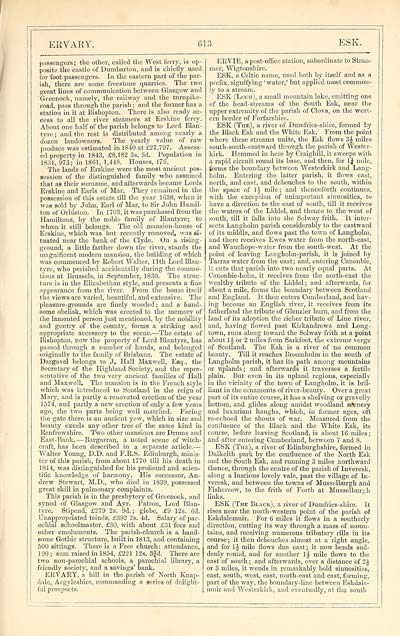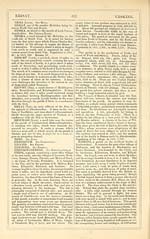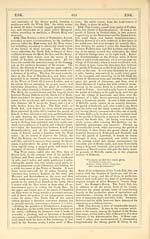Download files
Complete book:
Individual page:
Thumbnail gallery: Grid view | List view

ERVARY.
613
ESK.
passengers; the other, called the West ferry, is op-
posite the castle of Dumbarton, and is chiefly used
for foot passengers. In the eastern part of the par-
ish, there are some freestone quarries. The two
great lines of communication between Glasgow and
'Greenock, namely, the railway and the turnpike-
road, pass through the parish ; and the former has a
station in it at Bishopton. There is also ready ac-
cess to all the river steamers at Erskine ferry.
About one half of tbe parish belongs to Lord Blan-
tyre ; and tbe rest is distributed among nearly a
dozen landowners. Tbe yearly value of raw
produce was estimated in 1840 at £27,797. Assess-
ed property in 1843, £8,182 3s. 3d. Population in
1831, 973; in 1861, 1,448. Houses, 176.
The lands of Erskine were the most ancient pos-
session of the distinguished family who assumed
that as their surname, and afterwards became Lords
Erskine and Earls of Mar. They remained in tbe
possession of this estate till the year 1638, when it
was sold by John, Earl of Mar, to Sir John Hamil-
ton of Orbiston. In 1703, it was purchased from the
Hamiltons, by the noble family of Blantyre; to
whom it still belongs. The old mansion-house of
Erskine, which was but recently removed, was si-
tuated near the bank of the Clyde. On a rising-
ground, a little farther down the river, stands the
magnificent modern mansion, the building of which
was commenced by Bobert Walter, 11th Lord Blan-
tyre, who perished accidentally during the commo-
tions at Brussels, in September, 1830. The struc-
ture is in the Elizabethan style, and presents a- fine
appearance from the river. From the house itself
tbe views are varied, beautiful, and extensive. The
pleasure-grounds are finely wooded; and a hand-
some obelisk, which was erected to the memory of
the lamented person just mentioned, by tbe nobility
and gentry of the county, forms a striking and
appropriate accessory to the scene. — The estate of
Bishopton, now the property of Lord Blantyre, has
passed through a number of hands, and belonged
originally to the family of Brisbane. The estate of
Dargavel belongs to J. Hall Maxwell, Esq., the
Secretary of the Highland Society, and the repre-
sentative of the two very ancient families of Hall
and Maxwell. Tbe mansion is in tbe French style
which was introduced to Scotland in the reign of
Mary, and is partly a renovated erection of the year
1574, and partly a new erection of only a few years
ago, the two parts being well matched. Facing
the gate there is an ancient j r ew, which in size and
beauty excels any other tree of the same kind in
Renfrewshire. Two other mansions are Drums and
East- Bank. — Bargarran, a noted scene of witch-
craft, has been described in a separate article. —
Walter Young, D.D. and F.R.S. Edinburgh, minis-
ter of this parish, from about 1770 till his death in
1814, was distinguished for his profound and scien-
tific knowledge of harmony. His successor, An-
drew Stewart, M.D., who died in 1839, possessed
great skill in pulmonary complaints.
This parish is in the presbytery of Greenock, and
synod of Glasgow and Ayr. Patron, Lord Blan-
tyre. Stipend, £279 2s. 9d.; glebe, £9 12s. 6d.
Unappropriated teinds, £382 2 s. 4d. Salary of par-
ochial schoolmaster, £30, with about £31 fees and
other emoluments. The parish-church is a hand-
some Gothic structure, built in 1813, and containing
500 sittings. There is a Free church: attendance,
190 ; sum raised in 1854, £221 12s. 3|d. There are
two non-parochial schools, a parochial library, a
friendly society, and a savings' bank.
ERVARY, a hill in the parish of North Knap-
dale, Argyleshire, commanding a series of delight-
ful prospects.
ERVIE, a post-office station, subordinate to Stran-
raer, Wigtonshire.
ESK, a Celtic name, used both by itself and as a
prefix, signifying 'water,' but applied most common-
ly to a stream.
ESK (Loch), a small mountain lake, emitting one
of the head-streams of the South Esk, near the
upper extremity of tbe parish of Clova, on the west-
ern border of Forfarshire.
ESK (The), a river of Dumfries-shire, formed by
the Black Esk and tbe White Esk. From the point
where these streams unite, the Esk flows 3J miles
south-south-eastward through the parish of Wester-
kirk. Hemmed in here by Craighill, it sweeps with
a rapid circuit round its base, and then, for 14. mile,
forms the boundary between Westerkirk and Lang-
holm. Entering the latter parish, it flows east,
north, and east, and debouches to the south, within
the space of 1 J mile ; and thenceforth continues,
with the exception of unimportant sinuosities, to
have a direction to the east of south, till it receives
the waters of the Liddel, and thence to the west of
south, till it falls into the Solway frith. It inter-
sects Langholm parish considerably to the eastward
of its middle, and flows past the town of Langholm,
and there receives Ewes water from the north-east,
and Wauchope-water from the south-west. At the
point of leaving Langholm-parish, it is joined by
Tarras water from the east; and, entering Canonbie,
it cuts that parish into two nearly equal parts. At
Canonbie-holm, it receives from the north-east the
wealthy tribute of the Liddel ; and afterwards, for
about a mile, forms the boundary between Scotland
and England. It then enters Cumberland, and hav-
ing become an English river, it receives from its
fatherland the tribute of Glenzier burn, and from the
land of its adoption the richer tribute of Line river,
and, having flowed past Kirkandrews and Long-
town, runs along toward the Solway frith at a point
about 1 J or 2 miles from Sarkfoot, the extreme verge
of Scotland. The Esk is a river of no common
beauty. Till it reaches Broomholm in the south of
Langholm parish, it has its path among mountains
or uplands ; and afterwards it traverses a fertile
plain. But even in its upland regions, especially
in the vicinity of the town of Langholm, it is bril-
liant in the ornaments of river-beauty. Over a great
part of its entire course, it has a shelving or gravelly
bottom, and glides along amidst woodland scenery
and luxuriant haughs, which, in former ages, oft
re-echoed the shouts of war. Measured from the
confluence of the Black and the White Esk, its
course, before leaving Scotland, is about 16 miles;
and after entering Cumberland, between 7 and 8.
ESK (The), a river of Edinburghshire, formed in
Dalkeith park by the confluence of the North Esk
and the South Esk, and running 3 miles northward
thence, through the centre of the parish of Inveresk,
along a luscious lovely vale, past the village of In-
veresk, and between the towns of Musselburgh and
Fisherrow, to the frith of Forth at Musselburgh
links.
ESK (The Black), a river of Dumfries-shire. It
rises near the north-western point of the parish of
Eskdalemuir. For 6 miles it flows in a southerly
direction, cutting its way through a mass of moun-
tains, and receiving numerous tributary rills in its
course ; it then debouches almost at a "right angle,
and for 1J mile flows due east; it now bends sud-
denly round, and for another 1^ mile flows to the
east of south ; and afterwards, over a distance of 2$
or 3 miles, it wends in remarkably bold sinuosities,
east, south, west, east, north-east and east, forming,
part of the way, the boundary-line between Eskdale-
muir and Westerkirk, and eventually, at the south
613
ESK.
passengers; the other, called the West ferry, is op-
posite the castle of Dumbarton, and is chiefly used
for foot passengers. In the eastern part of the par-
ish, there are some freestone quarries. The two
great lines of communication between Glasgow and
'Greenock, namely, the railway and the turnpike-
road, pass through the parish ; and the former has a
station in it at Bishopton. There is also ready ac-
cess to all the river steamers at Erskine ferry.
About one half of tbe parish belongs to Lord Blan-
tyre ; and tbe rest is distributed among nearly a
dozen landowners. Tbe yearly value of raw
produce was estimated in 1840 at £27,797. Assess-
ed property in 1843, £8,182 3s. 3d. Population in
1831, 973; in 1861, 1,448. Houses, 176.
The lands of Erskine were the most ancient pos-
session of the distinguished family who assumed
that as their surname, and afterwards became Lords
Erskine and Earls of Mar. They remained in tbe
possession of this estate till the year 1638, when it
was sold by John, Earl of Mar, to Sir John Hamil-
ton of Orbiston. In 1703, it was purchased from the
Hamiltons, by the noble family of Blantyre; to
whom it still belongs. The old mansion-house of
Erskine, which was but recently removed, was si-
tuated near the bank of the Clyde. On a rising-
ground, a little farther down the river, stands the
magnificent modern mansion, the building of which
was commenced by Bobert Walter, 11th Lord Blan-
tyre, who perished accidentally during the commo-
tions at Brussels, in September, 1830. The struc-
ture is in the Elizabethan style, and presents a- fine
appearance from the river. From the house itself
tbe views are varied, beautiful, and extensive. The
pleasure-grounds are finely wooded; and a hand-
some obelisk, which was erected to the memory of
the lamented person just mentioned, by tbe nobility
and gentry of the county, forms a striking and
appropriate accessory to the scene. — The estate of
Bishopton, now the property of Lord Blantyre, has
passed through a number of hands, and belonged
originally to the family of Brisbane. The estate of
Dargavel belongs to J. Hall Maxwell, Esq., the
Secretary of the Highland Society, and the repre-
sentative of the two very ancient families of Hall
and Maxwell. Tbe mansion is in tbe French style
which was introduced to Scotland in the reign of
Mary, and is partly a renovated erection of the year
1574, and partly a new erection of only a few years
ago, the two parts being well matched. Facing
the gate there is an ancient j r ew, which in size and
beauty excels any other tree of the same kind in
Renfrewshire. Two other mansions are Drums and
East- Bank. — Bargarran, a noted scene of witch-
craft, has been described in a separate article. —
Walter Young, D.D. and F.R.S. Edinburgh, minis-
ter of this parish, from about 1770 till his death in
1814, was distinguished for his profound and scien-
tific knowledge of harmony. His successor, An-
drew Stewart, M.D., who died in 1839, possessed
great skill in pulmonary complaints.
This parish is in the presbytery of Greenock, and
synod of Glasgow and Ayr. Patron, Lord Blan-
tyre. Stipend, £279 2s. 9d.; glebe, £9 12s. 6d.
Unappropriated teinds, £382 2 s. 4d. Salary of par-
ochial schoolmaster, £30, with about £31 fees and
other emoluments. The parish-church is a hand-
some Gothic structure, built in 1813, and containing
500 sittings. There is a Free church: attendance,
190 ; sum raised in 1854, £221 12s. 3|d. There are
two non-parochial schools, a parochial library, a
friendly society, and a savings' bank.
ERVARY, a hill in the parish of North Knap-
dale, Argyleshire, commanding a series of delight-
ful prospects.
ERVIE, a post-office station, subordinate to Stran-
raer, Wigtonshire.
ESK, a Celtic name, used both by itself and as a
prefix, signifying 'water,' but applied most common-
ly to a stream.
ESK (Loch), a small mountain lake, emitting one
of the head-streams of the South Esk, near the
upper extremity of tbe parish of Clova, on the west-
ern border of Forfarshire.
ESK (The), a river of Dumfries-shire, formed by
the Black Esk and tbe White Esk. From the point
where these streams unite, the Esk flows 3J miles
south-south-eastward through the parish of Wester-
kirk. Hemmed in here by Craighill, it sweeps with
a rapid circuit round its base, and then, for 14. mile,
forms the boundary between Westerkirk and Lang-
holm. Entering the latter parish, it flows east,
north, and east, and debouches to the south, within
the space of 1 J mile ; and thenceforth continues,
with the exception of unimportant sinuosities, to
have a direction to the east of south, till it receives
the waters of the Liddel, and thence to the west of
south, till it falls into the Solway frith. It inter-
sects Langholm parish considerably to the eastward
of its middle, and flows past the town of Langholm,
and there receives Ewes water from the north-east,
and Wauchope-water from the south-west. At the
point of leaving Langholm-parish, it is joined by
Tarras water from the east; and, entering Canonbie,
it cuts that parish into two nearly equal parts. At
Canonbie-holm, it receives from the north-east the
wealthy tribute of the Liddel ; and afterwards, for
about a mile, forms the boundary between Scotland
and England. It then enters Cumberland, and hav-
ing become an English river, it receives from its
fatherland the tribute of Glenzier burn, and from the
land of its adoption the richer tribute of Line river,
and, having flowed past Kirkandrews and Long-
town, runs along toward the Solway frith at a point
about 1 J or 2 miles from Sarkfoot, the extreme verge
of Scotland. The Esk is a river of no common
beauty. Till it reaches Broomholm in the south of
Langholm parish, it has its path among mountains
or uplands ; and afterwards it traverses a fertile
plain. But even in its upland regions, especially
in the vicinity of the town of Langholm, it is bril-
liant in the ornaments of river-beauty. Over a great
part of its entire course, it has a shelving or gravelly
bottom, and glides along amidst woodland scenery
and luxuriant haughs, which, in former ages, oft
re-echoed the shouts of war. Measured from the
confluence of the Black and the White Esk, its
course, before leaving Scotland, is about 16 miles;
and after entering Cumberland, between 7 and 8.
ESK (The), a river of Edinburghshire, formed in
Dalkeith park by the confluence of the North Esk
and the South Esk, and running 3 miles northward
thence, through the centre of the parish of Inveresk,
along a luscious lovely vale, past the village of In-
veresk, and between the towns of Musselburgh and
Fisherrow, to the frith of Forth at Musselburgh
links.
ESK (The Black), a river of Dumfries-shire. It
rises near the north-western point of the parish of
Eskdalemuir. For 6 miles it flows in a southerly
direction, cutting its way through a mass of moun-
tains, and receiving numerous tributary rills in its
course ; it then debouches almost at a "right angle,
and for 1J mile flows due east; it now bends sud-
denly round, and for another 1^ mile flows to the
east of south ; and afterwards, over a distance of 2$
or 3 miles, it wends in remarkably bold sinuosities,
east, south, west, east, north-east and east, forming,
part of the way, the boundary-line between Eskdale-
muir and Westerkirk, and eventually, at the south
Set display mode to: Large image | Transcription
Images and transcriptions on this page, including medium image downloads, may be used under the Creative Commons Attribution 4.0 International Licence unless otherwise stated. ![]()
| Gazetteers of Scotland, 1803-1901 > Imperial gazeteer of Scotland, or, Dictionary of Scottish topography > Volume 1 > (741) Page 613 |
|---|
| Permanent URL | https://digital.nls.uk/97468022 |
|---|
| Description | Volume I: Aan-Gordon. |
|---|---|
| Attribution and copyright: |
|

